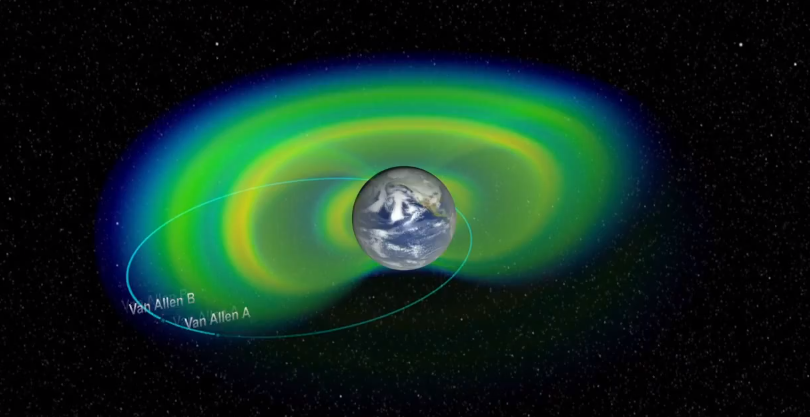Van Allen Probes reveal a new radiation belt around Earth

NASA’s Van Allen Probes mission has discovered a previously unknown third radiation belt around Earth, revealing the existence of unexpected structures and processes within these hazardous regions of space.
Previous observations of Earth’s Van Allen belts have long documented two distinct regions of trapped radiation surrounding our planet. Particle detection instruments aboard the twin Van Allen Probes, launched Aug. 30, quickly revealed to scientists the existence of this new, transient, third radiation belt.
The belts, named for their discoverer, James Van Allen, are critical regions for modern society, which is dependent on many space-based technologies.
The Van Allen belts are affected by solar storms and space weather and can swell dramatically. When this occurs, they can pose dangers to communications and GPS satellites, as well as humans in space.
“The fantastic new capabilities and advances in technology in the Van Allen Probes have allowed scientists to see in unprecedented detail how the radiation belts are populated with charged particles and will provide insight on what causes them to change, and how these processes affect the upper reaches of Earth’s atmosphere,” said John Grunsfeld, NASA’s associate administrator for science in Washington.
This discovery shows the dynamic and variable nature of the radiation belts and improves our understanding of how they respond to solar activity. The findings, published Thursday in the journal Science, are the result of data gathered by the first dual-spacecraft mission to fly through our planet’s radiation belts.
The new high-resolution observations by the Relativistic Electron Proton Telescope (REPT) instrument, part of the Energetic Particle, Composition, and Thermal Plasma Suite (ECT) aboard the Van Allen Probes, revealed there can be three distinct, long-lasting belt structures with the emergence of a second empty slot region, or space, in between.
“This is the first time we have had such high-resolution instruments look at time, space and energy together in the outer belt,” said Daniel Baker, lead author of the study and REPT instrument lead at the Laboratory for Atmospheric and Space Physics (LASP) at the University of Colorado in Boulder. “Previous observations of the outer radiation belt only resolved it as a single blurry element. When we turned REPT on just two days after launch, a powerful electron acceleration event was already in progress, and we clearly saw the new belt and new slot between it and the outer belt.”
Scientists observed the third belt for four weeks before a powerful interplanetary shock wave from the sun annihilated it. Observations were made by scientists from institutions including LASP; NASA’s Goddard Space Flight Center in Greenbelt, Md.; Los Alamos National Laboratory in Los Alamos, N.M.; and the Institute for the Study of Earth, Oceans, and Space at the University of New Hampshire in Durham.
Each Van Allen Probe carries an identical set of five instrument suites that allow scientists to gather data on the belts in unprecedented detail. The data are important for the study of the effect of space weather on Earth, as well as fundamental physical processes observed around other objects, such as planets in our solar system and distant nebulae.
“Even 55 years after their discovery, the Earth’s radiation belts still are capable of surprising us and still have mysteries to discover and explain,” said Nicky Fox, Van Allen Probes deputy project scientist at the Johns Hopkins University Applied Physics Laboratory in Laurel, Md. “We thought we knew the radiation belts, but we don’t. The advances in technology and detection made by NASA in this mission already have had an almost immediate impact on basic science.”
Source: NASA

i saw on another website that the outer newer van allen belt goes out to 25,000 miles. i wonder if the asteroid 2014 RC that going to be at that very distance from earth will affect that belt at that distance! lots of world shaking geological and sociological events are happening at the same time. wonder if it will cause anything to happen or maybe a rare auroral event! exciting times to be alive.
Technically, the particle wave has long been under suzerainty via humanities field of man-ipulated expertise related thereto, at least presently that we’re cognitive of….lol
I’m wondering if this could affect the brain wave? Anybody ?Thank you.
I’m certain HAARP has nothing to do with the radiation belts getting all swollen up from time to time. Heck! What could zillions of gigawatts of microwave radiation possible do to the ionosphere?
Just go back to fretting over breathing out CO2.